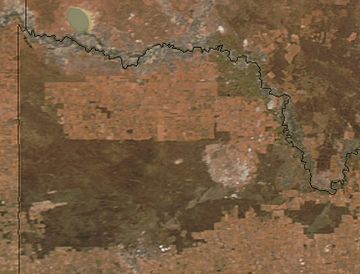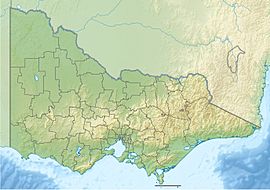Raak Plain boinka facts for kids
Quick facts for kids Raak Plain BoinkaVictoria |
|
|---|---|

NASA image. The darker green area to the west and center is the Murray-Sunset National Park. To its east the roughly circular light-colored area is the Raak boinka. East of this is the Hattah-Kulkyne National Park and the Murray River.
|
|
| Area | 400 square kilometres (150 sq mi) |
| Region | Murray Mallee |
The Raak Plain Boinka is a special wilderness area in Victoria, Australia. Imagine a shallow dip in the land, surrounded by sandy dunes. This area has unique features like gypsum flats (flat areas made of a mineral called gypsum) and salinas (pools of very salty water). These salty pools are mostly fed by water from underground. The plants that grow here are very special and many are rare or endangered.
Contents
What is the Raak Plain Boinka?
The Raak Plain Boinka is the biggest boinka in the Murray River area. It covers about 500 square kilometers. A boinka is a rare type of landform. It shows how water from underground can shape the land.
Where is the Raak Plain Boinka Located?
This unique area is about 16 kilometers northwest of Hattah, Victoria. It sits east of a raised area called the Sunset Strip. The boinka is north of Mount Cowra and Wymlet. The Calder Highway runs along its eastern side. The Hattah-Kulkyne National Park is also to the east of the highway. The boinka is part of the wider Murray Mallee plain.
Exploring the Raak Plain's Terrain
The Raak Plain is a great example of a boinka. It features sandplains, gypsum flats, and hills made of gypsite (a type of gypsum). There are also salinas and dunes formed by wind. This area is quite rugged. It has many salty blue lakes. These lakes are formed by water that comes up from deep underground.
Unique Landforms and Features
The Raak boinka is a wide, sunken area. It looks very different from the sandy Mallee landscapes around it. Inside, you'll find sand dunes and islands. There are also plains of sand, clay, and limestone. The lowest parts have gypsum flats and salinas filled with a mineral called halite (rock salt).
The boinka's floor is about 15 to 20 meters lower than the surrounding sand dunes. On the west side, the gypsum flats and salinas meet the dunes very sharply. But on the east, the sand from the boinka blends into the surrounding dunes. The plain also has "islands" that stick up. These are parts of the original dune field that became separated as the boinka grew.
Water and Salty Lakes
The Raak Plain has the largest amount of groundwater coming to the surface in Victoria. There are over 50 natural "playas," which are salty lakes. There are also plains covered in gypseous saltmarsh. Most of the salty water probably collected when the climate was wetter. Now, most of the water comes from the main Raak salina when it fills with rainwater.
MacArthur's Lake is a small salina in the southeast of the Raak boinka. It has shallow water in winter but dries out in warmer weather. The water in the lake becomes much saltier as it evaporates. By January, the water table is below the lake floor. The lake water is about 3.5 times saltier than the groundwater.
Soil and Ancient Dunes
The Raak boinka sits on top of a layer of Blanchetown Clay. The soils are mostly loose, reddish-brown sands. These sands form dunes in the middle of the plain. In the western part, you'll find salty soils that get wet during certain seasons.
Scientists have studied the age of the gypsum dunes here. They used a method called Optically stimulated luminescence (OSL). They found that these dunes formed between 20,000 and 35,000 years ago. Some older dunes formed between 70,000 and 85,000 years ago. One dune was even dated to around 127,000 years ago!
People and the Raak Plain
The Raak Plain has many important Aboriginal cultural sites. These include large areas with tools, ovens, and shell middens (ancient rubbish heaps). Shells from freshwater mussels, dating back about 7,650 years, have been found at an old Aboriginal campsite. This suggests that freshwater was once nearby. Even though the area was wetter back then, the underground water was salty. So, the freshwater might have come from "dune soaks." These are places where rainwater filters through dunes and gets trapped by a clay layer. Another idea is that the shells were brought from the larger Hattah Lake system nearby.
Land Use and Industry
Some of the land in the boinka is privately owned. Other parts are State Forest. These areas are used for grazing animals and for mining salt under special leases. About 18% of the boinka is used for grazing, mostly near Nowingi.
Gypsum is mined in Victoria. It is used to improve soil and to make plaster and plasterboard for building. Brunswick Plaster Mills used to have a railway to move gypsum from the Raak Plain. It went to a railway siding at Nowingi. You can still see the rusty remains of a fuel truck that exploded while carrying diesel to the gypsum mine.
Protecting the Raak Plain's Environment
The western part of the boinka is inside the Murray-Sunset National Park. A special area called the Raak Plain Reference Area, covering 15.43 square kilometers, is a very strict nature reserve. It is managed by the Department of Environment, Land, Water and Planning. This area is meant to protect nature.
Climate and Habitat
The Raak Plain gets about 250 millimeters of rain each year. But about 2500 millimeters of water evaporates! The difference is made up by groundwater coming to the surface. Because the area is naturally salty, it's not good for farming. This means about 82% of its original natural habitat is still there.
The plants here are very diverse. They include Samphire (Tecticornia) and Low Chenopod Shrubland.
Threatened Animals and Plants
Several threatened birds live here. These include the Regent parrot (Polytelis anthopeplus monarchoides) and the Malleefowl (Leipoa ocellata).
Threatened plants include Bead Glasswort (Tecticornia flabelliformis), Purple Swainson-pea (Swainsona purpurea), Mallee Hemichroa (Hemichroa diandra), and Spiked Pigweed (Dysphania simulans).
The A Directory of Important Wetlands in Australia lists about 40 individual wetlands here. They cover more than 600 hectares.
Environmental Concerns
The Raak Plain faces some threats. Rabbits eat young buloke trees, stopping them from growing. Foxes hunt the threatened Mallee birds that live on the ground. In 2004, there was a discussion about a plan for a waste storage site near Mildura. People were worried it could pollute the underground water.


